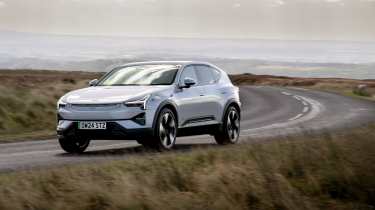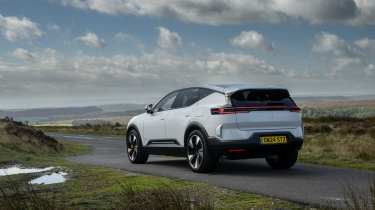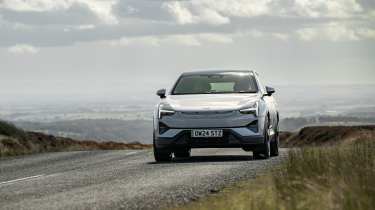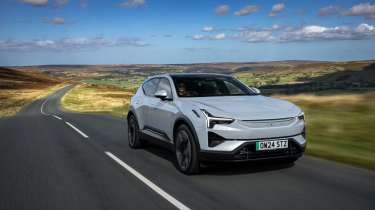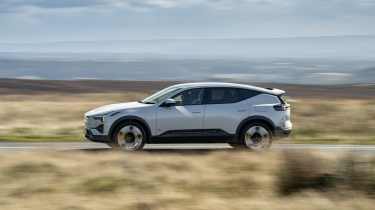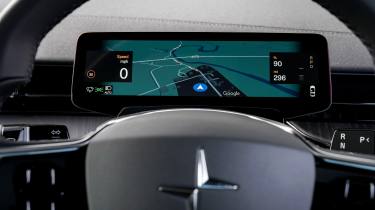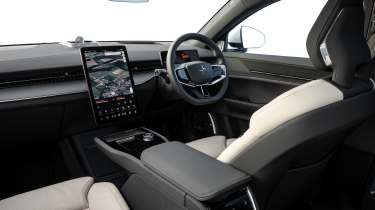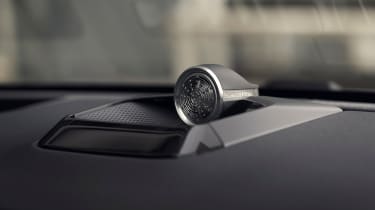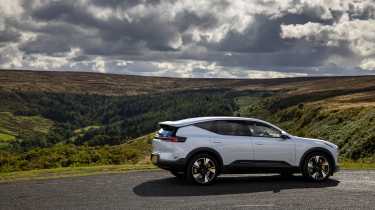Polestar 3 2024 review – Talented BMW iX rival has its niggles
A luxurious, composed, sharp-looking and competitively priced electric SUV it may be, with good power and solid dynamics. But the quirks and glitches aren’t gone…
The Polestar 3 and Polestar 4 are the all electric marque’s big swings during this brave new era of mainstream electric cars, taking aim squarely at established brands like BMW, Audi, Porsche, Tesla and Kia. Though we drove both overseas earlier this year, final judgement had to be reserved for UK drives, not only to judge their suitability to our roads but also, so that the cars we tried were as close to what buyers could expect to receive in terms of full functionality.
They’re certainly a change of pace from the Polestar 1 grand tourer that introduced us to the brand in 2018 and the popular 2 saloon. Up to now, the Polestar line-up has only ever included one model at a given time and soon, the highly-anticipated Polestar 5 and Polestar 6 will follow, making Polestar’s a five-car lineup.
Despite what the name suggests, the 3 is in fact larger than the 4, designed to rival the likes of the class-leading BMW iX and Audi Q8 e-tron as a five-seat E-segment electric SUV, rather than the Porsche Macan EV, Tesla Model Y and Kia EV6 GT that the Polestar 4 faces. As with all Polestar models though, it’s said to have been designed with a performance edge, with the firm claiming this c2600kg SUV ‘feels more like a sports car.’
> BMW iX M60 2024 review – it's fast, but is it worthy of the M badge?
Engine, gearbox and technical highlights
While an entry-level single motor version will be made available in due course, launch cars get a dual-motor all-wheel drive powertrain. Opt for the Long range Dual motor model with the Performance pack and outputs stand at 510bhp and 671lb ft of torque, in-line with the much more expensive BMW iX xDrive50. The power split is 245bhp/272bhp front-to-rear making it marginally rear-biased. Opt for the non-Performance pack dual motor powertrain and you get 483bhp and 620lb ft of torque.
In an effort to make the 3 more engaging and efficient, Polestar has installed a trick ‘dual-clutch’ torque vectoring unit on the rear axle for dual motor cars, taking the place of a conventional limited-slip differential. Developed by BorgWarner, the system allows the rear motor to completely disconnect while in low-demand scenarios. While similar solutions have already featured in numerous combustion cars, this is the first time the tech has been used in an EV.
During our first drive in Spain earlier this year, a glitch cropped up with the all-wheel drive system, with a fault message appearing on screen as the car went into limp mode. Though we never got to the bottom of the issue at the time, the effect was that the car was not sending power to the rear wheels at all, let alone via that trick new limited-slip diff.
Happily, as promised, the issue appears to have been ironed out. During our UK drive in the Cotswolds, no such niggles prevailed, with the Polestar 3 happily deploying its full 510bhp potency, while appreciably putting the differential to work, distributing power across the rear axle.
Performance and 0-62 time
A peak output of 510bhp in its most potent form is no match for the 610bhp BMW iX M60, but over 600lb ft of torque in both iterations makes it feel more than quick enough. If you’re coming from a combustion-powered alternative you’re very unlikely to be left wanting more power, but it does lack the brutal punch of the most potent EVs on the market today. In Performance pack-spec, the claimed 0-62mph time stands at 4.7sec with the ordinary dual motor taking an additional three tenths – top speed stands at 130mph for all models.
Despite the enormously high kerb weight, the Brembo brakes are up to the task, with strong regenerative braking blending with 400mm front and 390mm rear discs. Unlike some EVs, Polestar gives you the option to turn regenerative braking off entirely and while there are no dedicated brake modes, this option gives the pedal the most reassuring, natural feel, with a longer more linear pedal (increase the regenerative braking power to the ‘one-pedal’ mode and the pedal becomes shorter and more artificial in feel). Despite a slight degradation in brake pedal feel we found that the middle regenerative braking mode was best for a spirited drive, being the closest replication of conventional engine braking to allow for a more familiar feeling of flow.
Ride and handling
A 50:50 weight distribution and an identical centre of gravity to the Polestar 1 is certainly impressive, but that doesn’t change the fact that the 3 weighs 2670kg. While a hefty kerb weight is to be expected from a 107kWh EV, the laws of physics are hard to beat. In an effort to counteract them though, Polestar has thrown everything at the 3, including dual chamber air suspension and ZF active dampers as standard.
Figures within Polestar who have ordered the 3 as their next company car told us they did so because it’s the most driver focused of the two new models, in spite of the 4 being available with more power. That is true to an extent, with the the Polestar 3’s Geely-sourced Scalable Product Architecture 2 platform feeling more upmarket, utilising the LSD and conducting itself down a road with more precision than the 4 thanks to that air suspension. There’s less unceremonious wheel tramp under hard acceleration in the most powerful models and the wheels thud less in the arches over sudden disturbances.
It isn’t so much playful as it is willing, with that differential working the rear axle to guide the car more eagerly per your inputs. A squirt of throttle on the exit of a corner will have the Polestar 3 shimmying around to your chosen direction of travel in short order. The power isn’t crudely delivered either, with a pleasingly progressive throttle regardless of the power mode you’re in. During our drive in Spain our early car did suffer with a bit of a vibration both on throttle and when lifting off and regenerative braking. Once again, the car we drove in the UK showed that this issue was solved.
While it’s far from as playful as something like a Jaguar F-Pace SVR, it’s pleasingly neutral when pushing on, with understeer hard to reach. Its high weight figure does become apparent during consecutive direction changes, but plan ahead for the weight transfer and it’s easily managed.
Steering isn’t bustling with information but reassuring heft and good off-centre response inspires confidence, with just enough feedback sent back through the rim to convey a sense of load. The rack is a little slow for the tight mountain hairpins we tested it on, but on most roads it suits the 3’s character well.
On the smooth tarmac surrounding Spain’s capital, the primary ride was as soft and cosseting as you’d hope from such a car, with the 3’s long wheelbase contributing to impressive performance over larger bumps. Switch to the less-than-perfect surfaces of the country lanes in between Cotswolds villages, though, and smaller imperfections make themselves known in the cabin at normal speeds, lightly jostling occupants around at higher speeds and taking slightly longer to settle than we’d like.
In its firmest suspension setting ramps up the car’s control of itself across smoother, if more undulous surfaces, albeit while amplifying the small sudden bumps.
MPG and running costs
Polestar claims the 3 will use 38.9kWh of energy every 100 miles in ordinary dual-motor spec, with the Performance pack car using marginally more at 43.2kWh/100 miles. This equates to a 390-mile range (WLTP) in the standard dual-motor, or 349 miles in the Performance Package – almost identical to the figures quoted for the BMW iX in xDrive50 and M60-forms respectively.
In our experience, the calibration of its range calculation system is more accurate than most. Despite a variety of driving conditions (including not-so-efficient mountain roads), its range estimate remained consistent throughout the drive, staying true to the quoted WLTP range figures.
Though it doesn’t ride on an ultra-efficient 800V architecture like some new EVs, the 400V 3 makes the most of its 107kW power store with a standard heat pump, physical rear axle motor disconnect and a drag coefficient of 0.29cd, marginally behind the 0.25 figure of the BMW iX. Charging is said to take just 30 minutes from 10 - 80% when using a DC fast charger thanks to a 250kW peak charge rate, which is 55kW faster than the range-topping BMW iX.
Interior and tech
Step inside and it’s immediately clear that the 3 means business, with an abundance of black ash wood, repurposed aluminium and plush leather throughout. As with all Polestar models there’s a focus on sustainability, but the use of higher end materials gives it a more conventional luxury feel than other models in the range, with fewer bespoke materials and visibly recycled elements.
Elements such as soft close doors, a frameless rear view mirror and a neatly integrated 9-inch digital dashboard all contribute to a mature, refined overall feel. Piano black trim and hollow-feeling window controls aside, the 3 feels as substantial as you’d hope for a car of this calibre.
Although we heard a few squeaks and rattles over certain surfaces during our test, build quality feels great overall, with most touchpoints feeling reassuringly solid. Insulated glass all-round (and active noise cancellation with the £5000 Plus pack) makes it refined on most roads, but tyre and motor noise is more prominent than in the BMW iX.
The neoprene-like material on the dashboard is better than bare plastic, but does feel a little out of place amongst the wood and leather elsewhere. The touch-sensitive D-pads on the steering wheel are also not quite up-to-par with the rest of the cabin, lacking illumination and the tactility you’d expect from a premium product. What makes these even more frustrating is the fact they’re the only way to adjust the mirrors and steering wheel, with a total of five clicks required to do so. Thankfully, the seat and air vent controls are manual. The wheel and these controls are actually oddly different – the wheel itself of a higher quality feel – to those on the Polestar 4 because of the difference in platform. We’re told the Polestar 4 has more in common underneath with a Lotus Eletre, than the Polestar 3.
The heart of the cabin is the central 14.5–inch portrait infotainment display, running the same snappy Android Automotive system as the rest of the Polestar range. While it’s underpinned by Google software, Polestar has added its own unique skin. BMW’s latest iDrive feels more responsive, but the attention to detail in Polestar’s system is second to none – icons featuring a car show the silhouette of the 3 as opposed to a generic model, with bespoke animations for driving modes and settings dotted throughout the UI. Split screen functionality and customisable widgets aim to make the user experience more fluid, but more physical buttons for certain controls would be welcome.
The interior also features some unique design elements, with the boot lid featuring a window in the roof. As this is virtually impossible to see from any seat in the cabin, its only real purpose is to pull additional light into the cabin. Thanks to the use of air suspension, Polestar has also been able to integrate a suspension lowering button into the boot for easier loading (the air suspension has 60mm of range from its lowest point to highest).
We’ve yet to sample a car equipped with it, but Polestar is offering the 3 with an optional £4300 LiDAR system, adding a pod to the roof to allow for autonomous driving functions in the future. This system adds three additional cameras to the existing five and a LiDAR unit from Luminar – the standard car also includes five radar modules and 12 ultrasonic sensors.
A driver attention monitor comes as standard too, and while these safety systems didn’t prove to be too invasive, we did still experience some brief phantom braking on the motorway during our drive. What we did observe on our UK drive was that the parking cameras seemed to be out of action from the off, with a warning on the black screen saying ‘Camera view temporarily unavailable. Press home button to close.’
There’s a 1610w B&W sound system on offer too, featuring Dolby Atmos support and integrated headrest speakers for improved immersion – despite the impressive specs, we found this system to have less impact than the class-leading offering in the BMW iX, but software updates and EQ tweaks could improve this with time.
Design
Designed by the team behind the striking Precept concept from 2020, the Polestar 3 has numerous clever design elements usually reserved for more exclusive, low-volume models. While its large dimensions are hard to hide, the use of black elements along the bottom quarter do a good job of reducing visual mass, with Polestar’s trademark ‘Thor’s hammer’ LED headlights and slim grille shared with the rest of the range.
What’s unique for the 3 is a passthrough aero element on the bonnet, acting as a functional aerodynamic device to keep airflow attached over the car and through the rear wing, which also serves a function – both of these elements feature vortex generators on the underside and help improve both efficiency and aero.
There are also a pair of aero elements aft of the rear wheels to cleanly detach airflow, with slightly odd blanking plates for US reflectors sitting above the headlights. While some manufacturers might compromise the headlight design in order to integrate this reflector into the unit, Polestar chose to keep it separate in this instance. Wing mirrors are sophisticated frameless items similar to those seen on Aston Martin’s latest models, and Polestar says digital units are a consideration for the future (the Polestar 4 already does without a rear window, relying on a camera for rear visibility).
First previewed on the Polestar 1, the 3 also retains the marque’s unique ‘prototype’ aesthetic with visible sensor heating elements on the front grille and model decals aft of the wheels, similar in aesthetic to the prototype stickers used on McLaren test mules.
The 3’s design is sophisticated and sharp overall, making it one of the most visually appealing in this class. The standard diamond cut 22-inch forged wheels on the Performance pack car look great, too, with the ordinary dual motor getting 21-inch items – tyres are 265-section front, 295-section rear, with Pirelli P Zeros standard on the Performance pack and Michelin PS4 EVs or Continental SportContact 7s standard on the ordinary dual motor.
Price and rivals
In the not-so distant past, the Polestar 3 wouldn’t have had many rivals, but things are hotting up in the electric premium SUV space. The BMW iX is perhaps its closest current rival, majoring on cruising comfort, quality and sustainability, with the Audi Q8 e-tron also targeting the same corner of the market. Volvo’s EX90 will be hitting the market in the coming months as a less sporting SPA2-based option.
At £75,900, the Long range Dual motor Launch Edition represents great value for money in the class, putting it in-line with the much less potent 322bhp BMW iX xDrive40 and 335bhp Q8 e-tron Sport 50 quattro. Step up to the 510bhp Performance pack and you’ll pay an additional £5600, but this still positions it £22,785 below the equally-powerful BMW iX xDrive50. While the Polestar 3 is not quite as well rounded as its Munich rival, that saving is impossible to ignore.
